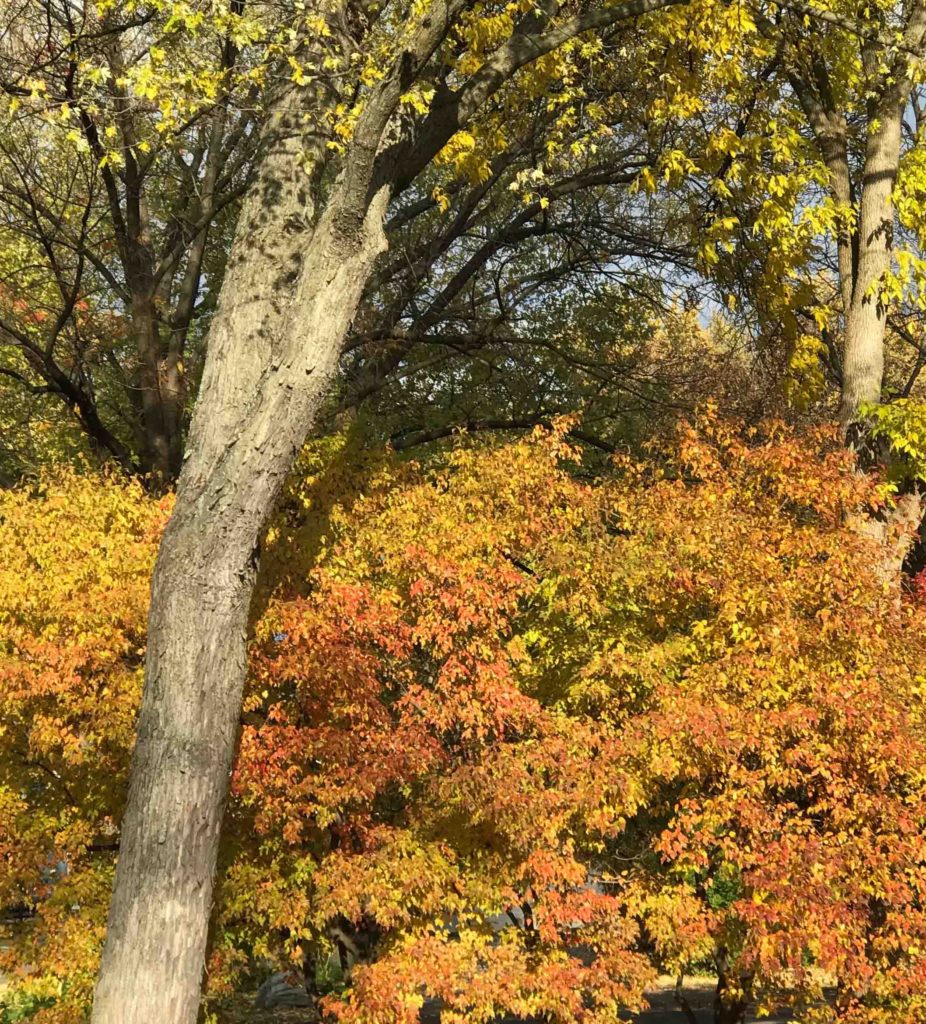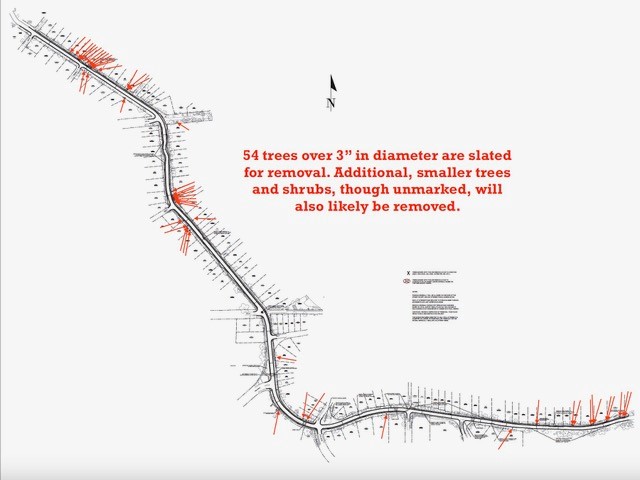Trees
Tree Canopy Importance
The trees that provide a canopy over Lake Mendota Drive need to be preserved. Many of the trees that create the Lake Mendota Drive canopy are over 50 to 100 years old and cannot be replaced. Some trees are greater than 300 years old. The street canopy provides a beautiful and comfortable environment for people to walk and enjoy.
An informal count of significant trees next to Lake Mendota Drive numbered over 100. Some canopy trees have already been lost due to disease and invasive insects brought on by the unintended consequences of human activities. The city terrace tree list has been limited to pollution tolerant species which further threatens the existing canopy as the City of Madison views those trees as candidates for logging.
These trees should not only be preserved because they are aesthetically pleasing but also because they play a critical role in fighting global warming, air and water pollution by reducing urban heat islands.

Heat islands
Heat islands are created by cities when they replace natural land cover with concentrations of pavement, buildings, and other surfaces that absorb and retain heat. This effect increases energy costs (e.g., for air conditioning), air pollution levels, and heat-related illness and mortality.
In the name of progress, the elimination of natural land cover and increase in hard surfaces continues unchecked in larger buildings, homes, streets, sidewalks, parking lots and driveways. The result of this human centered development is a clearing of forests and natural environments around the world. The Lake Mendota Drive reconstruction project is a microcosm of this global problem. The same human benefit logic that is used around the world is also used in Madison to justify cutting down trees and to create as much or more hardscape that will create heat islands.
Heat islands increase demand for air conditioning to cool buildings. In an assessment of case studies spanning locations in several countries, electricity demand for air conditioning increased approximately 1–9% for each 2°F increase in temperature. Countries where most buildings have air conditioning, such as the United States, had the highest increase in electricity demand.[1] This increase demand contributes to higher electricity expenses.
Tree Care & Construction
The majority of the urban forest in the City of Madison exists on private residential and commercial properties so the decisions made by these property owners are critical to the number of trees in Madison and their health. (source: City of Madison Urban Forestry Task Force Final Report for Discussion and Review 2019)
Before engaging in a construction or landscaping project, consult with an arborist about the health of your trees and how they can be bolstered above and below ground. Root treatments can help a tree survive a construction project. An arborist can tell you when a construction project may be too close to the trees roots and make it unlikely to survive.
It is commonly thought that the roots of a tree reach out to the end of the dripline. However, this is an assumption. “Trees are never the same shape below ground as they are above, so it is difficult to predict the length of location of their roots. Typically, however, approximately 90-95% of a tree’s root system is in the top 3 feet of soil, and more than half is in the top 1 foot. The part of this root system in which construction damage should be avoided is called the Protected Root Zone (PRZ).” If a tree is healthy it may survive root cutting but it also depends on the tree species. Some tree species are extremely sensitive to root cutting even outside the dripline. (source: Protecting trees from construction damage: a homeowners guide, University of Minnesota Extension)
Oak Wilt Concerns
If you have red oak trees there are treatments to help prevent oak wilt for those trees at high risk due to nearby oak wilt. Oak wilt has been detected in 50 of 72 Wisconsin counties as of December 2021. It is caused by a fungus that inhibits the tree from moving water which is quickly fatal to a red oak in a matter of weeks. Oak wilt can spread overland by beetles carrying the fungus on their bodies and landing on a fresh wound on the tree, or once in a tree can then spread to the root system and infect other trees. Property owners should refrain from oak trimming, root cutting during oak wilt season which is April through July. The safest time to trim a red oak tree is in the Fall. (source: Wisconsin DNR)
In the City of Madison, the seriousness of oak wilt and the need to protect oak trees resulted in the passage of the below ordinance:
Removal or Pruning of Oak Trees Prohibited. No person, firm or corporation shall remove, trim or prune any oak tree or portion thereof between April 1 and October 15 without first securing the written permission of the City Forester, or designee. (Am. by Ord. 11,012, 10-12-94; Ord. 13,640, 6-23-04; ORD-08-00071, 7-04-08)
Trees as a Habitat
In 2019, Science magazine reported on the findings of Dr. Ken Rosenberg, applied conservation scientist at the Cornell Laboratory of Ornithology. Dr. Rosenberg and his team of experts reported that wild bird populations in the U.S. and Canada have declined by almost 30% since 1970.
Trees play a part in the size and health of the bird population. They are the home of many bird species. They need a tree habitat especially during the bird nest-to-fledgling period (typically May to July). Beyond nesting and raising young, many bird species need trees for cover and protection from predators.
Birds also need vertical diversity in trees as they live and nest at different levels. Old and declining trees are overlooked but are great habitat for birds. Many species of owls prefer mature and over-mature trees. Often these are the trees that are harvested when they need to be left in place for birds to use as their home.
trees and global warming: the problem and the solutioin
The scientific consensus is crystal clear. According to virtually every science organization in the world, climate change threatens the future of mankind if nothing is done to stop it in the very near future. Paradoxically, trees are at the root of the problem and the solution.
Two leading causes of global warming over the past 200 years are 1) burning carbon-rich fossil fuels, which causes the greenhouse effect, and 2) cutting down half the world’s trees, which significantly increases solar heating of the environment. Scientists are working on ways to control carbon in forms other than heat, but they cannot succeed fast enough to avoid serious disruption of life as we know it.
The world’s leading scientific authority in this area, the Intergovernmental Panel on Climate Change (IPCC), just decreed that governments must immediately implement net zero policies to cut greenhouse gas emissions as close to zero as possible—that is, to stop making the problem worse. For example, government-driven construction projects anywhere in the world should include adding at least enough trees to compensate for those they eliminate.
To its discredit, the City of Madison is planning to eliminate 50 or more established trees along Lake Mendota Drive; more will subsequently die due to construction damage. Tell your Alder and the Mayor to take this project back to the drawing board, now. Tell them the revised plan should show exactly where new trees will be planted—as close as possible to those they replace, and as many additional new (i.e., smaller) trees as necessary to fully replace the lost canopy. Planting them somewhere else won’t save the tree canopy that makes Lake Mendota Drive so special to people from all over the city.
Invasive Species Update
The City of Madison has decreed that the number of trees along Lake Mendota Drive must be reduced to make room for sidewalks; it believes that improving pedestrian safety is the #1 problem the project must solve. However, Lake Mendota Drive has not had a single car-pedestrian accident as long as the City has been collecting data in this area, and the lush tree canopy is a major reason why so many Madisonians flock to this shared-use parkway. Even local residents with mobility limitations—those presumably most concerned with access—strongly oppose trading trees for sidewalks.
City officials have openly rejected the neighborhood’s strong preference for trees by arguing that many are invasive species to be removed even if the road were not being resurfaced. There’s a long-standing and untouchable City policy that favors native species and pollution-resistant trees to types of trees that have migrated here from other geographic areas. Like so many of Madison’s policies that are blindly supported by Alder Furman (who also happens to be President of the Common Council), it is largely out-of-touch with the emerging scientific consensus.
New data demonstrate that global warming threatens the survival of native species in areas where they existed for centuries. Hence, trees that thrived in Wisconsin’s 20th century climate are starting to decline as temperatures rise. They are replaced naturally by trees from states to the south that are also becoming warmer, etc. Change in an area’s tree population is therefore a natural result of climate change. Fighting blindly against so-called invasive species prevents replacements that can thrive in our warming climate. (Some invasive trees are brought into the area unnaturally, which is a real but different problem.) Please help save one of our area’s most beautiful public areas by telling the City officials to accept new trees that are better suited to the new climate than many of the traditional trees they are committed to preserve. As climate changes, so must our trees.
social equity and trees
Mayor Rhodes-Conway and Alder Furman inappropriately apply some social arguments in defense of their project. Almost all who live on or near LMD are committed to racial equality, equal opportunity, and other core dimensions of social justice, but they do not understand how City officials can use these values to justify replacing trees with sidewalks that do not enhance the vaunted access to stores or bus routes. There are no public or private services anywhere along the way! The project is a total waste of money from the perspective of such social concerns. An extensive neighborhood survey showed it is even opposed by a strong majority of residents with mobility limitations.
The City’s Lake Mendota Drive project also ignores extensive neighborhood focus on other ways the project’s funds could be spent. The money could produce highly desirable improvements in public health and social welfare by improving safety of the drinking water in Well 19—reducing serious health risks to thousands of residents in District 19 and beyond. To prevent pedestrian deaths, the money could be spent instead on East Washington Avenue where citizens are actually being killed. Or if Alder Furman really cared about pedestrian safety, he could have promoted a walking bridge over nearby University Avenue, the next East Washington.
For all Madisonians, socially marginalized or not, LMD’s value is fundamentally defined by natural resources. We who live here love having visitors come from all over the City to enjoy walking, bicycling, swimming, picnicking, fishing, and other leisure activities made more enjoyable by trees. For many residents with lower income, Lake Mendota Drive is a particularly healthy place to be because of the trees and the respite they provide. Remind City Hall that the trees along this beautiful parkway are for all to enjoy. Spend money on trees or sidewalks to improve Lake Mendota Drive? Social equity clearly favors the trees.

See Also
University of Minnesota – Protecting trees from construction damage https://conservancy.umn.edu/handle/11299/199785
Dane County – Preserving Trees During Construction http://www.treeboard.org/tree-care/preservation
City of Madison Urban Forestry Task Force Report 2019 https://www.cityofmadison.com/streets/forestry/UrbanForestryTaskForcePlan.cfm
Wisconsin DNR – Oak Wilt https://dnr.wisconsin.gov/topic/foresthealth/oakwilt
Oak Wilt Prevention & Control https://extension.umn.edu/plant-diseases/oak-wilt-minnesota
Trees & Wildlife https://wwv.isa-arbor.com/quizbank/resources/4575/Arborist_and_Wildlife_2018_02.pdf
Trees & Birds https://www.arborday.org/trees/bulletins/coordinators/resources/pdfs/102.pdf